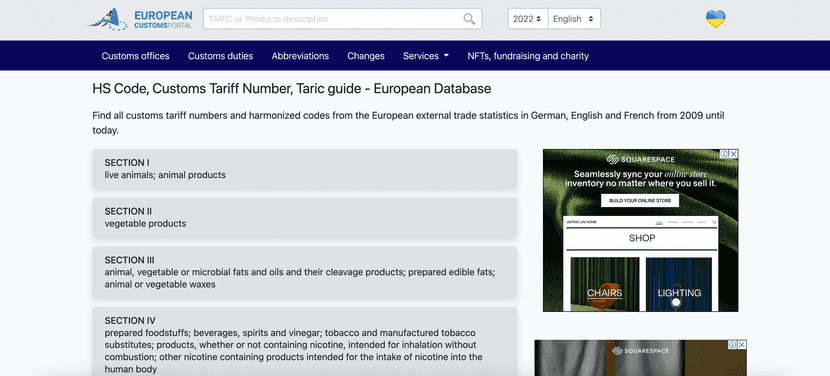If you’re reading this article, chances are you are already shipping internationally and you have come across HS codes and the bureaucracy required for these shipments. The documentation, the costs, the hassle with couriers, and delivery times are some of the aspects that vary most with respect to domestic shipments.
The online retail market continues to grow on a global scale. However, to offer shipments to countries outside of the EU, you will undoubtedly need to get familiarized with the Harmonized System.
The HS code system can be difficult to navigate at first. However, as you use this harmonized tariff code system, you’ll become more comfortable with it, and the identification of the right code for your products will be faster and easier.
But...
What is the HS code?
Unlike domestic shipments or shipping within the EU, international shipments must go through a more complex, lengthy, and expensive process.
Hence, the importance and existence of the HS code. The HS (Harmonized System) code is an international item identifier.
This code, in general, is made up of six digits that represent in an intelligible way a product or category of products. It's used in over 200 countries and, in a nutshell, aims to facilitate the exportation and importation of products throughout the world.
This product classification system is renewed every 5 years, so it’s important that you check for possible updates.
In 2022, a series of rectifications and updates to the HS codes were implemented for certain products such as electrical and electronic waste (e-waste), for new products related to tobacco or nicotine, new items commonly known as drones, and for smartphones (Source: World Customs Organization).
If your online store sells these products, you must pay special attention when cataloging them under one HS code or another.
The Harmonized Commodity Description and Coding System is very detailed. Specifically, there’s an HS code for 98% of the products that are currently shipped through online stores and eCommerce businesses, including drones and cigarette alternatives.
This level of complexity is one of its strengths, but also what makes it difficult to use at first. It’s also why you can make mistakes in choosing the HS code of your products, and there are consequences that this can have on international shipments. But we will talk about this in another section.
How will I find the HS code of a product?
To find out the HS code of your product, you can check the different product sections on the European Customs Portal and choose the chapter, heading, and subheading that suits your product the best.
You can also do a simple search on the internet, although you must be sure of the sources you use. Opting for the official pages is always the best option.
If you already know the TARIC code of your goods, you should know that the first six digits match (or should match) the HS code.
What is the Harmonized System (HS)? Origin of the HS code
The HS code was born thanks to the International Convention on the Harmonized Commodity Description and Coding System in 1983, and came into force in 1988.
This international trade treaty replaces previous agreements and has the purpose of standardizing international customs procedures. In other words, it facilitates the sale of goods by using a harmonized system with application in a large number of countries.
There are 157 contracting parties that signed this International Agreement (156 countries and the European Union, with all its Member States). As you can imagine, the whole of the EU and 156 countries offer endless business opportunities for your online store or eCommerce business, regardless of the products you sell.
In this Agreement, the use of the aforementioned harmonized system is agreed upon, with all the benefits that this entails for international trade.
The organization in charge of regulating the HS codes is the World Customs Organization (WCO). This international body has the function of creating new codes for new products, as well as updating HS codes or modifying those headings and subheadings that require it.
They are also responsible for providing information to regular exporters - such as online stores - to help them interpret how HS codes work. This prevents the generation of customs problems and enables the harmonized system to work in a much more efficient way, ensuring its long-term success.
Why is the HS code important?
The HS code identifies products internationally during exports. It’s also used to calculate the duties or taxes that must be paid in customs clearance to ensure the legality of the product importation, and to collect data about export and import operations.
The HS code is a fundamental tool for international trade, making it faster, easier, and more efficient. The unequivocal signaling of the product will make the customs authorities know what exactly the package contains.
Prior to the existence of this system, exporting goods frequently ended up with issues because of language barriers, cultural differences, or the clash of two different bureaucratic systems.
Using the HS code in your international shipments isn’t only mandatory, but a preventative measure that will save your online store shipping issues, costs, and time.
If you have customers in areas with a different tax system, you probably already know that the speed at which you deliver your products is key when it comes to building customer loyalty worldwide.
You don't have to think about exotic places like Bali or Barbados. The United Kingdom or the USA are some of the destinations to which you probably ship more or less regularly. One of the ways you can ensure that products pass customs control without delays or extra costs is by adding the HS code to your products.
What’s the format of the HS code?
The HS code format usually consists of six digits, with more numbers indicating more information and specificity.
For example, in the case of selling cotton T-shirts, you must enter the code 61091000. The first two numbers (61) refer to the type of item it is and the way it is made (knitted clothing and accessories); 6109 indicates that it’s within the knitted shirts and vests category; 610910 indicates the material used for its production: cotton.
HS codes are grouped into a number of categories that make it easy to find the right code for each product. The following information will help you understand better how an HS code is made up.
Sections
The harmonized system has 21 sections that are not part of the HS code. The purpose of these is simply to indicate the category within which you should search for the first digits of your products’ HS codes.
Each category includes a wide variety of products, always with a common denominator. For example, continuing with the previous case, its section would be number 11: Textiles and textile articles, which groups the chapters (explained below) that go from number 50 to number 63. As you can see, number 11 doesn’t appear at any time in the HS code.
Now that you have found the section, you only have to search among its chapters to find the one that best matches your product.
Chapters
Within each section, you can find a variable number of chapters, with a total of 99 different chapters. At this point, you will begin to understand the hierarchical structure of the HS code.
More digits mean a higher degree of specificity.
From these chapters, you will get the first two digits of your HS code: ‘Garments and accessories (accessories), clothing, knitted’ (61) is the category that comes closest to our cotton T-shirt example.
The next phase is choosing the starting point for your product.
Headings
There are 21 sections, 99 chapters, and 1,244 headings to choose from.
In this case, the combination ‘«T-shirts» and T-shirts, knitted’ seem to be the most suitable numbers for our product, cotton T-shirts. We already have the following figures for our HS code: 6109.
Now, we only have two digits left to complete the HS code, which is necessary to make international shipments.
Subheadings
The subheadings are the last part needed to specify the products either by material, by the level of preparation, or by following another criterion. In the harmonized system of HS codes, there are a total of 5,224 subheadings.
Specifically, the subheading for our cotton T-shirt is the material (cotton): 10.
610910 would be the complete code needed to ship our cotton T-shirts internationally.

Where is the HS code used?
HS codes are of vital importance when shipping internationally. These codes must be included in all customs documents that are necessary for the country of destination of the products.
The most used documents, generally speaking, are the commercial invoices and the CN22 or CN23 forms.
If the country of destination has another system of tariff codes, you should also include it in these documents.
Consequences of choosing the wrong HS code
Now that you know what the HS code is, what it is used for, what its format is, and how you can find out the HS code of your products, it’s time to find out what the consequences of choosing the wrong HS code are.
Some of the most frequent consequences of not including the HS code - or selecting the wrong HS code for your product - are unplanned tax charges, delivery delays, or even rejection at customs.
Another situation that can arise if an online store doesn’t deliver the documents correctly, either due to errors in the data or due to loss or lack of documentation, is the return of the shipment to its origin.
The online store will need to pay the expenses derived from the shipment from the customs office to the warehouse, explain the situation to the customer, and offer an alternative to avoid losing a buyer.
Other tariff code systems
The HS code is a tariff code used in over 200 countries in Africa, Asia, America, Oceania, and Europe. However, some of these countries have other tariff codes similar to the HS code.
For example, in the United States, there is the HTS code (Harmonized Tariff Schedule) made up of a series of digits that can range from 8 to 10. The HTS code has a similar purpose to that of the HS code and is provided by the International Trade Commission of the USA.
Its use is limited to those sales and shipments to the United States. If you ship to this country, you should check the HTS code of your products on its official portal.
The TARIC code is the identifier code of the European Union. Although it has the same function as the HS code, its scope of use is different. This code seeks to facilitate export and import operations from or to the EU.
Therefore, its use only makes sense when one of the parties is in the EU. You can check the TARIC code of your products on the official website of the European Commission.
For shipments to the European Union or within the EU, four digits of the HS code are used followed by two digits of the Combined Nomenclature (CN) and two digits of the Integrated Tariff of the European Communities (TARIC). For example, for a cotton T-shirt, the tariff code would be 6109100010.
In addition to these codes, you can find other similar tariff codes such as the Mercosur Common Nomenclature (NMC) or the Chinese tariff code, made up of 13 digits in which seven additional digits are added to the standard HS codes. These codes, like the previous ones, are unique to a specific country or set of countries.
Which code should I use to ship to…?
The tariff code will depend on the tariff code required by the importing country. That is, the country you are shipping to. If you ship to one of the countries or geographic areas mentioned above, you must use the regulatory tariff code of the destination of your shipments.
If that country or region doesn’t have its own tariff code, you should use the HS code.
Documents required for exports
The HS code, TARIC code, or any other identification code will be included in a series of essential documents for the arrival of your products on time and without incident. Some of the documents needed to export are:
- Commercial invoice
- Certificate of origin
- Customs invoice
- CN22 and CN23 forms, depending on the value of the goods
Remember that the HS code changes frequently to deal with new regulations, new products, and new export trends.
Including the wrong HS code on customs documents can negatively impact your business, from the generation of unplanned costs to delivery delays or hold-ups at customs.
Being up-to-date on tariff legislation is key when it comes to avoiding this type of shipping issue, and it may be the only way to retain and foster loyalty among those international customers that you worked so hard to achieve.
It is also important to consider the needs of customers. In the case of online sales, the most frequent questions that buyers have regarding their orders are: which courier is doing the delivery, where the package is, and what the status is: in preparation, sent, in the process of delivery, etc.
But don’t forget about the return policy since it is a key factor that buyers look at before making a purchase. The reason is simple. Returns are unavoidable; whether the customer wants to carry them out or not, the data reveals that 1 in 5 products purchased online end up being returned.
With this information, it’s easy to imagine the benefits of offering a returns portal that makes the process easier for your customers. Automating the return process for the online store and its customers is something that can be done in less than 10 minutes through Outvio.
Thanks to this post-checkout platform, you'll be able to streamline and accelerate internal operations such as order processing, shipping, tracking and returns and improve your communications with customers by using Outvio's marketing and customer support tools.
Conclusions
If you still have questions about the HS code, you can find more information on the official portals of the countries, on the web pages of the national and regional Chambers of Commerce, or on the official portal of the World Customs Organization.
Being sure of how the international sales and shipping process work and the documentation you must provide will save you from unpleasant surprises in the future. It will also ensure that your online store has an optimized logistics process designed to meet your needs and those of your buyers.




